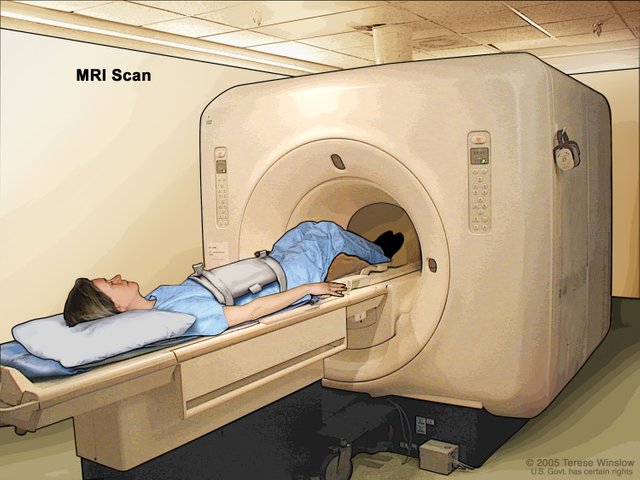
Source
Magnetic resonance imaging (MRI) is a noninvasive medical imaging technique that uses magnetic fields and radio waves to generate detailed images of the inside of the body. Its basic principle is based on the interaction between the magnetic field and protons (mainly hydrogen) present in water and other compounds in the body.
La resonancia magnética (RM) es una técnica de imagen médica no invasiva que utiliza campos magnéticos y ondas de radio para generar imágenes detalladas del interior del cuerpo. Su principio básico se basa en la interacción entre el campo magnético y los protones (principalmente en el hidrógeno) presentes en el agua y otros compuestos del cuerpo.
A high-power magnet (usually 1.5T to 7T in clinical equipment) aligns the hydrogen nuclei in the body. A radiofrequency wave destabilizes this alignment, causing the protons to spin in different directions. When the radiofrequency is turned off, the protons return to their initial state, releasing signals that are captured by the equipment's detectors, which are subsequently translated into detailed images using reconstruction algorithms.
Un imán de alta potencia (generalmente de 1.5T a 7T en equipos clínicos) alinea los núcleos de hidrógeno en el cuerpo. Una onda de radiofrecuencia desestabiliza esta alineación, haciendo que los protones giren en diferentes direcciones, cuando se apaga la radiofrecuencia, los protones regresan a su estado inicial, liberando señales que son captadas por los detectores del equipo que posteriormente se traducen en imágenes detalladas mediante algoritmos de reconstrucción.

Source
Image resolution depends on several factors, such as magnetic field strength and acquisition parameters. In standard clinical MRI, resolution varies between 1 mm and 0.5 mm, but now a group of scientists at the Weizmann Institute of Science have developed an innovative technique that allows imaging of individual molecules at the atomic scale, overcoming the limitations of traditional MRI.
La resolución de las imágenes depende de varios factores, como la intensidad del campo magnético y los parámetros de adquisición. En RM clínica estándar, la resolución varía entre 1 mm y 0.5 mm, pero ahora un grupo de científicos del Instituto Weizmann de Ciencias han desarrollado una técnica innovadora que permite obtener imágenes de moléculas individuales a escala atómica, superando las limitaciones de la resonancia magnética tradicional.
This method uses quantum sensors based on nitrogen defects in synthetic diamonds. These sensors, due to their atomic size and quantum nature, are extremely sensitive to nearby changes and can differentiate the presence of individual electrons. This makes it possible to determine the exact location of an electron in three dimensions with an accuracy of 0.09 nanometers.
Este método utiliza sensores cuánticos basados en defectos de nitrógeno en diamantes sintéticos. Estos sensores, debido a su tamaño atómico y naturaleza cuántica, son extremadamente sensibles a cambios cercanos y pueden diferenciar la presencia de electrones individuales. Esto permite determinar la ubicación exacta de un electrón en tres dimensiones con una precisión de 0,09 nanómetros.

Source
The possibilities are immense: by understanding the structure of proteins and other biological molecules at the atomic level, more effective drugs with fewer side effects can be designed. It allows diseases to be identified at the molecular level, which could lead to more accurate and earlier diagnoses. Or the development of materials with specific properties, such as greater resistance, conductivity or flexibility.
Las posibilidades son inmensas: al entender la estructura de las proteínas y otras moléculas biológicas a nivel atómico, se pueden diseñar fármacos más efectivos y con menos efectos secundarios. Permite identificar enfermedades a nivel molecular, lo que podría conducir a diagnósticos más precisos y tempranos. O el desarrollo de materiales con propiedades específicas, como mayor resistencia, conductividad o flexibilidad.
But despite the advances, there are still technical and theoretical challenges that need to be addressed. For example, imaging molecules in motion or in aqueous environments remains a challenge. Furthermore, analyzing the large amounts of data generated by these techniques requires the development of sophisticated computational tools.
Pero, a pesar de los avances, aún existen desafíos técnicos y teóricos que deben abordarse. Por ejemplo, obtener imágenes de moléculas en movimiento o en ambientes acuosos sigue siendo un reto. Además, el análisis de grandes cantidades de datos generados por estas técnicas requiere el desarrollo de herramientas computacionales sofisticadas.
More information/Más información
https://wis-wander.weizmann.ac.il/space-physics/molecular-close?utm_source=chatgpt.com
Con este avance aún por resolver desafíos técnico y teóricos, abren las puertas a otras escalas antes inimaginables para el estudio biológico y molecular.
Muy interesante tema de avance científico.
Saludos y éxitos.
Downvoting a post can decrease pending rewards and make it less visible. Common reasons:
Submit
It is really a beautiful thing to learn about the new methods that have been developed. There is really a massive development ahead and which I am so sure of. It is definitely just a matter of time
Downvoting a post can decrease pending rewards and make it less visible. Common reasons:
Submit